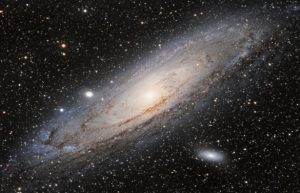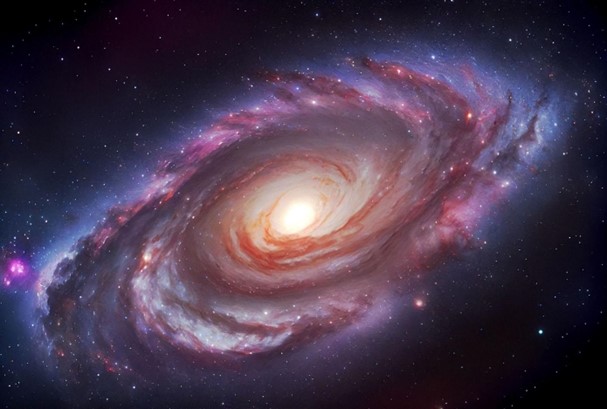The Milky Way is often envisioned as a tranquil spiral galaxy—home to life as we know it, cradle for millions of planetary systems, stars, and other celestial bodies. However, few people know that behind the serenity of these spirals lies a far more sinister reality.
The Milky Way thrives on destruction. For billions of years, our galaxy has engulfed smaller galaxies—dismantling them, assimilating their stars, and absorbing their dark matter and gas. This destruction leaves behind remnants that shape the Milky Way’s structure and evolution, such as disrupted orbits, dark matter halos, and stellar streams. Astronomers call this phenomenon galactic cannibalism.
Galactic cannibalism is not merely an act of destruction; it is an essential mechanism for the evolution of galaxies. It contributes to both creation and destruction in the cosmos. The Milky Way’s growth and complexity have been profoundly influenced by these mergers, collisions, and gravitational interactions, making galactic cannibalism a cornerstone of cosmic evolution.

The Gaia Sausage: An Ancient Merger
The Gaia Sausage is the most well-documented example of the Milky Way’s cannibalistic past.
Gaia-Enceladus, a dwarf galaxy, collided with the Milky Way approximately 8–10 billion years ago. It was identified through stellar motion data from the European Space Agency’s Gaia mission. The nickname “Gaia Sausage” originates from the elongated shape revealed by this data.
This dwarf galaxy was substantial, with an approximated stellar mass of 600 million solar masses. When it merged with the Milky Way, its stars were torn apart and dispersed, contributing to the formation of the thick stellar halo—a diffuse population of stars encircling the galaxy.
This collision profoundly altered the layout of the Milky Way. Violent gravitational forces tugged at the existing stars and gas clouds, thickening the disk and inducing star formation. These newly formed stars are believed to constitute a substantial fraction of stars present in the Milky Way’s disk today. Stars from Gaia-Enceladus continue to exist, dispersed in the halo, functioning as vestiges of history for the galaxy’s tumultuous past.
According to Dr. Vasily Belokurov from the University of Cambridge:
“The Gaia Sausage event was transformative. It modified the framework of the Milky Way and, on the other hand, added a vast amount of dark matter to its mass.”
This dark matter altered the Milky Way’s gravitational potential, facilitating its current structure. Studies of the Gaia Sausage have given pivotal findings into the distribution and behavior of dark matter. By testing cosmological models, we can deepen our understanding of galactic mergers and their role in contributing to the dark matter distribution in large galaxies.

The Sagittarius Dwarf Galaxy: Today’s Victim
While the Gaia Sausage represents the Milky Way’s ancient history, the Sagittarius Dwarf Galaxy is a present-day example of galactic cannibalism in action. Discovered in 1994, this small elliptical galaxy is being torn apart by the Milky Way’s gravitational pull. It orbits the galaxy in a highly eccentric trajectory, where formidable tidal forces pull apart the stars, generating prominent tidal streams that encircle the Milky Way.
Simulations and detailed modeling indicate that the Sagittarius Dwarf Galaxy has already contributed to the Milky Way’s outer stellar halo. Within a few hundred million years, it is anticipated that the residual stars of the Sagittarius Dwarf Galaxy will either be assimilated by the Milky Way or disperse into the universe. This process will mark the complete assimilation of Sagittarius into the Milky Way’s structure. Observations from the Sloan Digital Sky Survey (SDSS) and the Gaia satellite have extensively mapped these stellar streams, providing undeniable evidence of the Milky Way’s appetite for smaller galaxies.

The Andromeda Galaxy: The Future Victim
Looking to the distant future, Andromeda, the Milky Way’s proximal neighbor, is destined to be its upcoming prey. In approximately 4.5 billion years, the Milky Way is predicted to merge with its neighbor. Recent observations from the Hubble Telescope have brought to light that Andromeda is hastening toward the Milky Way at a velocity of 110 kilometers per second.
Despite the vast distances between individual stars making direct collisions unlikely, the interaction between the two galaxies will trigger a complex gravitational dance. This cosmic ballet will involve not only stars but also gas and dark matter, leading to intricate distortions and interactions. This inevitable event will mark a radical modification for both galaxies, fundamentally altering their systems to their cores.
The collision will commence the formation of new stars, as dense gas clouds of both galaxies converge, guiding a new wave of star formation. Ultimately, the two galaxies will give rise to a massive elliptical galaxy. During this process, the Milky Way will shed its characteristic spirals while paving the way for a new epoch in galactic evolution. Astronomer Dr. Priyamvada Nataranjan aptly characterizes the phenomenon as “cosmic rebirth.” While the cataclysm of the Milky Way’s current structure is inevitable, the collision will generate novel prospects for stellar evolution, significantly reshaping the cosmos. This future confrontation between the Milky Way and Andromeda highlights the cyclic nature of galactic life—where destruction is a crucial precursor to creation, and the universe continues to evolve in the cycle of transformation.
The cannibalistic past of the Milky Way illustrates the duality of destruction and creation in the universe. While these mergers involve the violent destruction of smaller galaxies, they also enable the formation of new stars and structures. Without the absorption of Gaia-Enceladus, the Milky Way’s thick stellar halo would not exist. Similarly, the ongoing merger with the Sagittarius Dwarf Galaxy continues to reshape the Milky Way’s outer regions. Moreover, future interactions such as the collision with Andromeda will continue to transform the galaxy, marking the end of its spiral form and the beginning of a new chapter in its history. As our understanding of galactic cannibalism deepens, it reveals not only the violent nature of cosmic evolution but also the profound interconnectedness of the universe.
















